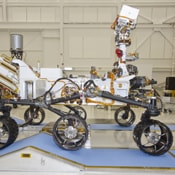

Venerable Mars Rover Begins Study of Brand-New Site
The Mars rover Opportunity may be a senior citizen, but it’s still as spry as ever, and as it peers over the rim of the giant impact crater called Endeavour, it’s embarking on what could be called a new mission, say its NASA guides.
“You’re coming along with us to a brand new geologic field site,” said Steve Squyres, Cornell astronomy professor and principal investigator of the Mars Exploration Rover mission.
The rover arrived Aug. 9 at Cape York, on the rim of Endeavour, after a three-year journey of about 13 miles as it detoured to avoid numerous hazards along the way.
Endeavour, an impact crater 14 miles in diameter, offers tantalizing clues about the Red Planet’s early formative process. Squyres described Tisdale 2, the first rock Opportunity has examined at the rim of Endeavour, as a breccia—composed of chunks of fragmented rock. It has the scientists excited because it’s unlike any rock they’ve explored so far on Mars.
Tisdale 2 is a basaltic rock that has a composition similar to some volcanic rocks, but most striking so far is the large amount of zinc in its chemical makeup, Squyres said. For rocks on Earth, zinc is an element typically found in a place with hydrothermal (hot water) activity.
“This is a clue that we may be dealing with a hydrothermal system here,” Squyres said. “We may have a situation where water has percolated or flowed or somehow moved through these rocks—maybe as vapor or maybe as liquid. We don’t know yet.”
It is too early to tell whether the rock’s composition indicates evidence of water on Mars, Squyres said, but the initial observations point to what he expects will be a “long and interesting story about these rocks.”
Opportunity will next drive northeast to search for bedrock along Cape York. Questions to be answered, according to Squyres: Does the zinc composition vary from place to place? Is it concentrated along fractures where water can move easily? Does the zinc correlate with other elements also associated with moving water?
The twin Mars rovers Spirit and Opportunity landed on the Red Planet in 2003 for what was expected to be a 90-day mission. Spirit stopped communicating in March 2010, and scientists are cautiously optimistic about Opportunity’s scientific future, even after more than seven years of wear and tear.
The science team selected Endeavour as Opportunity’s long-term destination after the rover climbed out of Victoria crater three years ago. The mission had spent two years studying Victoria, which is about one twenty-fifth as wide as Endeavour. Layers of bedrock exposed at Victoria and other locations Opportunity has visited share a
sulfate-rich composition linked to an ancient era when acidic water was present. Opportunity drove about 13 miles from Victoria to reach Endeavour. It has driven 20.8 miles since landing on Mars.
“We have a very senior rover in good health for having already worked 30 times longer than planned,” said John Callas, project manager for Opportunity at JPL. “However, at any time, we could lose a critical component on an essential rover system, and the mission would be over. Or, we might still be using this rover’s capabilities beneficially for years. There are miles of exciting geology to explore at Endeavour crater.”
NASA will launch its next-generation Mars rover, Curiosity, between Nov. 25 and Dec. 18, 2011. It will land on Mars in August 2012.
You can contact Bob Eklund at [email protected], or visit his websites at www.bobeklund.com and firststarbook.com.


Be the first to comment